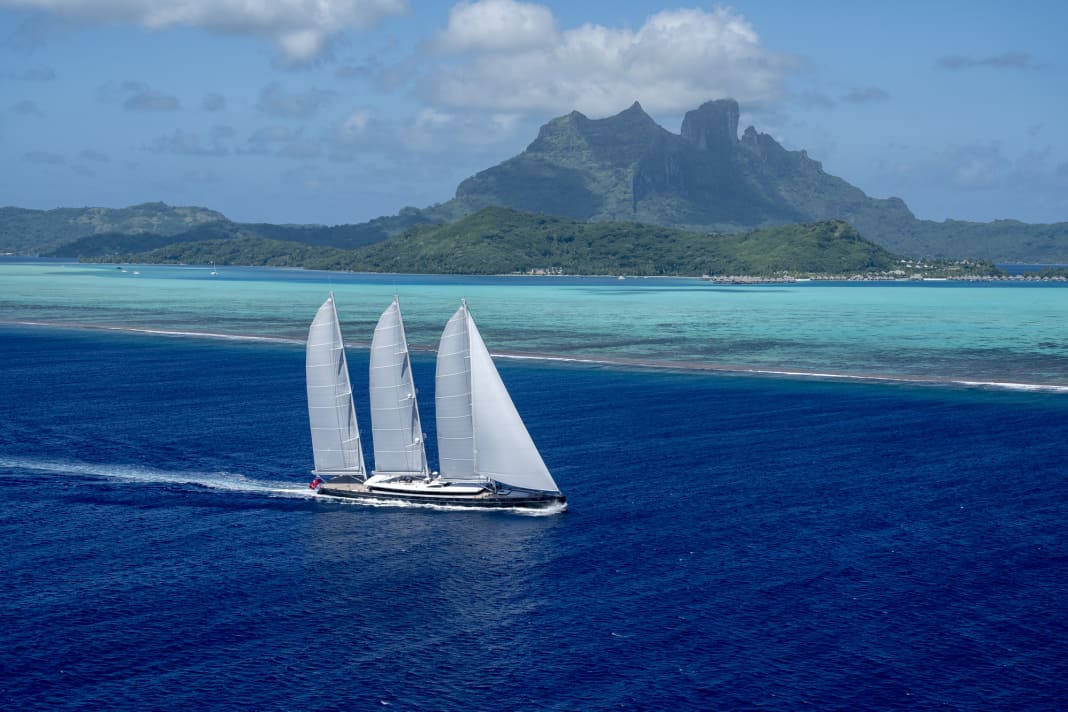





Royal Huisman delivered "Sea Eagle II" in 2020 in the shadow of the pandemic and welcomed the aluminium construction back to the Netherlands for overhaul in 2022. At this point, the three-masted schooner had already travelled a long way. She now has more than 45,000 nautical miles in her logbook. It is another milestone in the 125-year history of the traditional shipyard and, at 81 metres, is the second-longest yacht in the Huisman fleet after the 90-metre "Athena".
The idea for the sailing superlative matured in the owner while sailing around the world on his 43-metre sloop of the same name and shipyard origin. He was looking for an extremely comfortable and spacious yacht with good seaworthiness and exceptional amenities for guests and crew. She was to have excellent long range qualities so that the owner could see as much of the world under sail as possible. A true tall ship interpreted in a modern way: practical, powerful, safe and easy to handle.
The hull speed of 22 knots is quickly reached
During initial sailing tests, "Sea Eagle II" logged 21.5 knots in a moderate breeze on the North Sea, half a knot below hull speed. On the cross, there are 2580 square metres of Doyle sails in the wind, and 3552 square metres on rough courses. According to Royal Huisman's shipyard captain, the hydraulics are so powerful that all three mainsails can be hoisted at the same time without any problems - which should take no longer than with slips half the size.
The efficiency of the sail systems is based on complex hull and rig calculations by Dykstra Naval Architects. Although the hull and superstructure are made of aluminium, the Dutch engineers had to deal with different strengths. As very large glass surfaces extend through the main deck, the superstructure flexes differently to the hull. The solution is a glued connection for the front part, which compensates for movements of up to two centimetres. The aft part of the superstructure was welded on.
In order to get from the Pacific to the Atlantic quickly, Huisman's sister company Rondal laminated the three Carbo-Masts to be Panamax-compliant; they rise 61 metres into the sky from the water surface and thus correspond to the maximum clearance heights of the Panama Canal bridges. The furling booms and the standing rigging of Carbo-Link are also made of carbon fibre. The world's longest carbon rudder blade, at five metres, is made of the same material. Rondal also supplied 34 hydraulic winches, twelve of which rotate on deck and 22 below deck. The sheets can carry up to 18 tonnes.
Unforgettable charter for twelve people
BOOTE EXCLUSIV was able to walk through the 1150 gross tonnes of interior space for 12 guests and 14 crew members during construction and experience the timeless elegance of the Mark Whiteley interior. On the lower deck there are two master suites, three double cabins and a fitness room that can be converted into a cabin for children, nannies or additional crew. Whiteley also contributed to the straight-lined exterior, which he developed alongside Dykstra.
Those who join the British brokerage house will experience an unforgettable charter week. Burgess transfers 550000 euros. Although this only covers the use of the yacht, the deal seems more than tempting. For comparison: motor yachts of comparable length - with twice the interior volume, but for the same number of guests - are listed for just under one million euros a week. A big difference, especially as the consumption advantage of the sailing yacht should not be neglected. This is because the charter rate does not include other costs such as fuel, catering or tips for the crew.
The next record-breaking construction is already in the starting blocks at Royal Huisman: In Vollenhove in the Netherlands, work is progressing on an 85-metre-long Slup, which is also being welded from aluminium, but according to plans by Frers Design.
You can read the full portrait of "Sea Eagle II" in BOOTE EXCLUSIV issue 4/23, which will be published on 28 June 2023.
Technical data "Sea Eagle II"
- Length over everything: 81 m
- Width:12 m
- Depth: 6 m
- Exterior styling:Dykstra Naval Architects + Mark Whiteley Design
- Interior Styling: Mark Whiteley Design
- Construction:Dykstra Naval Architects
- Hull speed: 22 kn
- Material: Aluminium
- Class: Lloyd's MCA (LY-3)
- Motors:2 x 1081 kW, Caterpillar C32
- Generators:2 x 120 kW, Caterpillar C7.1
- battery system:120 kWh for load control
- Rig: Rondal
- Mast height: 61 m
- Sail area (on the wind):2580 square metres
- sail area (before the wind): 3552 square metres
- Sail: Doyle Sails, High Roach Stratis
- Integrated sail systems: Rondal

